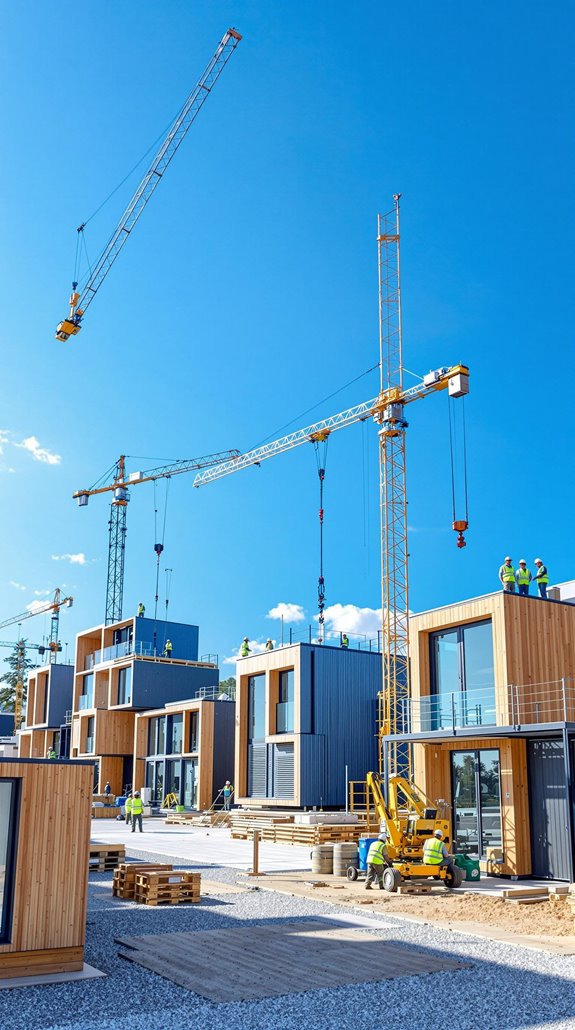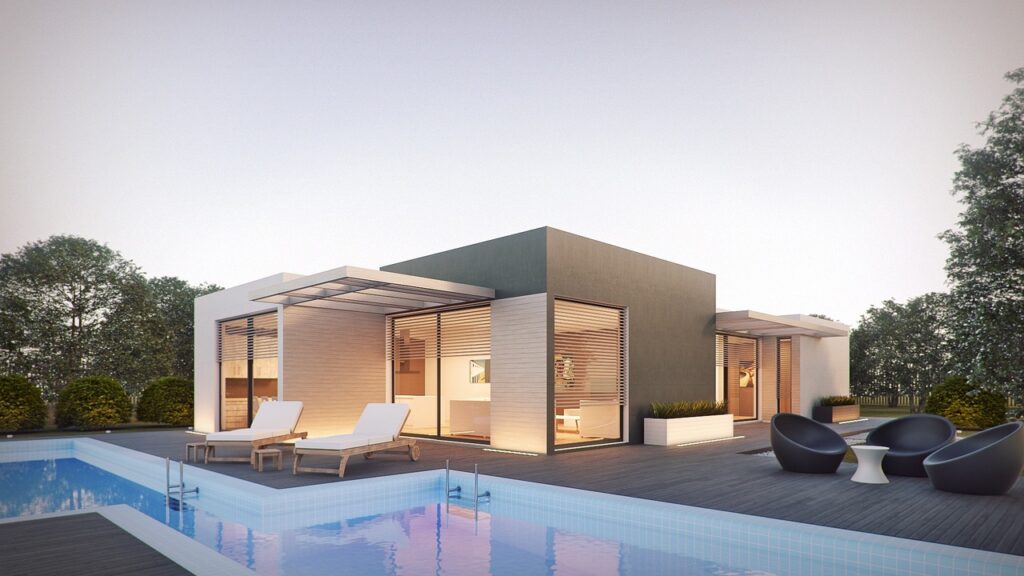I’ve been tracking the UK’s housing crisis for years, and I’m convinced modular construction offers our most viable path forward. While traditional building methods struggle with rising costs and chronic delays, factory-built homes deliver 50% faster timelines and 10-25% cost savings. The numbers don’t lie—we need 300,000 new homes annually, yet current methods can’t meet demand. What’s particularly compelling is how this technology addresses multiple challenges simultaneously, creating opportunities that most industry observers haven’t fully grasped yet.
Key Takeaways
- Modular homes deliver 10-25% cost savings compared to traditional construction through reduced labor requirements and material optimization.
- Construction timelines are compressed by 50%, with modular homes completed in 3-6 months versus 6-12 months for conventional builds.
- Government allocated £39 billion for affordable housing with 40% dedicated to modern construction methods including modular systems.
- Factory-controlled production reduces material waste by 90% and energy consumption by up to 90% compared to traditional methods.
- Modular construction can help deliver 300,000 new homes annually needed to address the UK’s housing supply crisis.
The Speed Revolution: How Modular Construction Cuts Build Times by Half

The construction industry’s traditional timelines are being revolutionized by modular housing, which cuts build times by an impressive 50% compared to conventional methods. I’ve observed how factory-based production eliminates weather delays and logistical challenges that typically plague traditional builds. While conventional homes require 6-12 months, modular construction delivers completed homes in just 3-6 months.
What makes this possible is the controlled factory environment where components are manufactured simultaneously with site preparation. You’ll find that on-site assembly takes only days rather than months, with modules arriving ready for immediate installation by crane. The CITB reports an 80% reduction in on-site labor for modular projects due to factory precision. This isn’t just theoretical—UK manufacturers currently produce 3,300 homes annually using these accelerated methods, proving that we can consistently deliver quality housing faster than ever before. Additionally, as with house extensions, modular housing offers homeowners an efficient way to expand without the lengthy disruptions common in traditional builds.
Breaking Down the Economics: Why Modular Homes Cost 10-25% Less
While speed advantages capture headlines, modular housing‘s most compelling benefit lies in its fundamental cost structure that delivers 10-25% savings over traditional construction.
I’ve analyzed the economics, and three core factors drive these savings. First, labor efficiency: factory-based construction slashes on-site requirements by 30%, while automated processes eliminate specialty trade coordination delays. Second, material optimization: bulk purchasing and precise factory cutting reduce waste by 90%, with integrated supply chains eliminating middle-man markups. Third, operational efficiency: concurrent site preparation and factory fabrication compress timelines by 50-90%, reducing equipment rental and construction loan interest. Additionally, incorporating 3D printed construction techniques can further enhance these efficiencies by streamlining the building process.
Quality control advantages compound these savings—factory precision minimizes rework costs, while standardized modules ensure consistent material usage. The energy-efficient designs built into modular homes further reduce long-term ownership costs through substantially lower utility bills. For us seeking affordable housing solutions, these aren’t just statistics—they represent tangible pathways to homeownership.
Green Building for a Net-Zero Future: Environmental Benefits of Modular Construction
Beyond cost savings, modular construction delivers compelling environmental advantages that position it as a cornerstone technology for achieving the UK’s net-zero targets by 2050.
I’ve observed how factory-controlled environments minimize material waste through precision engineering and automated assembly. You’ll find that streamlined production processes reduce energy consumption by up to 90% compared to traditional construction, while centralized sourcing cuts transport-related emissions considerably. Greener materials like bamboo, reclaimed wood, and recycled steel offer sustainable alternatives to conventional concrete and brick that emit CO2 during production. Additionally, the potential for lower construction costs in modular housing projects can further enhance the appeal of sustainable building practices.
The energy performance benefits are equally impressive. High-grade insulation and airtight modular designs maintain stable temperatures year-round, reducing heating demands. I recommend focusing on integrated energy-saving systems and renewable energy compatibility that support your net-zero goals.
What excites me most is the waste minimization potential. Factory prefabrication achieves near-zero material waste, while modular components designed for disassembly enable future reuse—creating true circular construction solutions.
Tackling the UK Housing Crisis: 300,000 Homes and the Modular Solution
As UK housing costs spiral beyond reach for millions, modular construction emerges as the most viable pathway to deliver the government’s ambitious target of 300,000 new homes annually. I’ve analyzed the stark numbers: average UK rents hit £1,339 monthly, surging 7.0% year-on-year, while traditional housing starts dropped 9% to just 28,180 units in Q1 2025. You’re witnessing a supply crisis that demands radical solutions. Modular construction offers the speed and scalability we desperately need. While conventional completions fell 5% year-on-year, modular systems can deliver homes 50% faster through off-site manufacturing. The housing market shows clear signs of strain, with property transactions plummeting 28% from April 2024 to just 65,000 transactions in April 2025. Additionally, these homes can be built using sustainable insulation to further minimize their environmental impact. I believe this technology represents our best chance to close the housing gap and restore affordability for working families across Britain.
Investment Opportunities in the UK’s Fastest-Growing Construction Sector
The numbers paint a compelling picture for investors seeking exposure to Britain’s construction revolution. I’m seeing sector growth exceeding 15% annually through 2030, with industry leaders achieving 118% year-on-year turnover growth. You’ll find multiple strategic entry points: joint ventures with established manufacturers, urban regeneration projects, and build-to-rent portfolios.
The financial advantages are substantial. Construction costs drop 10-25% versus traditional methods, while faster completion times deliver ROI in 3-6 months rather than 6-12. Government backing strengthens the investment case—£39 billion committed to affordable housing with 40% mandated for modern construction methods. Additionally, affordable home renovation costs can further enhance the overall value of modular properties.
Risk mitigation comes through factory-controlled environments, precision manufacturing, and fixed-price contracts. Projects generate significantly fewer vehicle movements to construction sites, reducing logistical costs and environmental impact. For investors wanting diversification into sustainable assets, modular housing offers compelling exposure to Britain’s construction transformation.
Conclusion
I’ve shown you how modular construction transforms UK housing delivery through 50% faster build times, 10-25% cost reductions, and superior environmental performance. You’re looking at a sector that’s addressing the 300,000-home shortfall while offering concrete investment opportunities. The technical advantages—factory precision, waste minimization, and standardized processes—make modular housing the practical solution for Britain’s housing crisis. It’s not just future potential; it’s today’s most viable construction methodology for scalable, affordable housing delivery.
References
- https://homemove.com/content/unpacking-the-boom-how-modular-housing-is-reshaping-the-uk-property-market/
- https://www.grandviewresearch.com/horizon/outlook/modular-construction-market/uk
- https://concept-capital-group.com/news/top-destination-for-modular-housing-investments/
- https://www.approachpersonnel.co.uk/blog/uk-construction-mid-year-review-2025-housing-civils-amp-new-growth-areas-fueling-jobs-across-the-country
- https://www.cornerstoneprojects.co.uk/blog/modular-construction-in-2025-how-off-site-building-is-reshaping-uk-development/
- https://www.keyman.uk.com/the-future-of-modular-construction-in-the-uk
- https://www.themanufacturer.com/articles/homebuilding-revolution-set-to-come-of-age-as-traditional-builders-fail-to-tackle-housing-crisis/
- http://ieomsociety.org/ieom2020/papers/564.pdf
- https://www.thelandsite.co.uk/articles/what-can-global-and-uk-stats-tell-us-about-modular-construction
- https://mistermodular.co.uk/2025/02/28/how-much-do-modular-buildings-cost/

